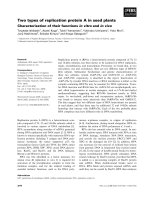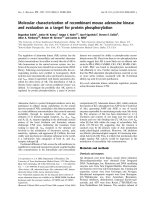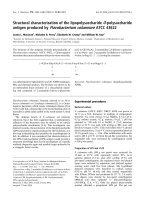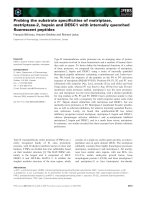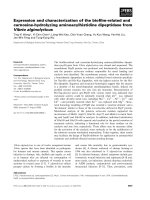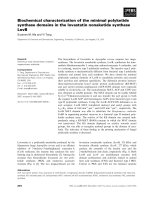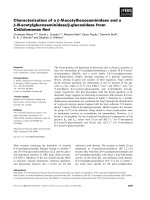Characterization of Indian cattle breeds, Ongole and Deoni (Bos indicus) using microsatellite markers pot
Bạn đang xem bản rút gọn của tài liệu. Xem và tải ngay bản đầy đủ của tài liệu tại đây (350.47 KB, 16 trang )
Genome Biology 2004, 5:P8
Deposited research article
Characterization of Indian cattle breeds, Ongole and Deoni
(Bos indicus) using microsatellite markers
Muralidhar Metta
1
, Sriramana Kanginakudru
2
, Narasimharao Gudiseva
1
,
Javaregowda Nagaraju
2
Addresses:
1
Department of Animal Genetics and Breeding, College of Veterinary Science, A NG R Agricultural University, Hyderabad 500
030, India.
2
Centre for DNA Fingerprinting and Diagnostics, ECIL Road, Nacharam, Hyderabad 500 076, India.
Correspondence: Jawaregowda Nagaraju. E-mail:
comment
reviews
reports
deposited research
interactions
information
refereed research
.deposited research
AS A SERVICE TO THE RESEARCH COMMUNITY, GENOME BIOLOGY PROVIDES A 'PREPRINT' DEPOSITORY
TO WHICH ANY ORIGINAL RESEARCH CAN BE SUBMITTED AND WHICH ALL INDIVIDUALS CAN ACCESS
FREE OF CHARGE. ANY ARTICLE CAN BE SUBMITTED BY AUTHORS, WHO HAVE SOLE RESPONSIBILITY FOR
THE ARTICLE'S CONTENT. THE ONLY SCREENING IS TO ENSURE RELEVANCE OF THE PREPRINT TO
GENOME BIOLOGY'S SCOPE AND TO AVOID ABUSIVE, LIBELLOUS OR INDECENT ARTICLES. ARTICLES IN THIS SECTION OF
THE JOURNAL HAVE NOT BEEN PEER-REVIEWED. EACH PREPRINT HAS A PERMANENT URL, BY WHICH IT CAN BE CITED.
RESEARCH SUBMITTED TO THE PREPRINT DEPOSITORY MAY BE SIMULTANEOUSLY OR SUBSEQUENTLY SUBMITTED TO
GENOME BIOLOGY OR ANY OTHER PUBLICATION FOR PEER REVIEW; THE ONLY REQUIREMENT IS AN EXPLICIT CITATION
OF, AND LINK TO, THE PREPRINT IN ANY VERSION OF THE ARTICLE THAT IS EVENTUALLY PUBLISHED. IF POSSIBLE, GENOME
BIOLOGY WILL PROVIDE A RECIPROCAL LINK FROM THE PREPRINT TO THE PUBLISHED ARTICLE.
Posted: 4 March 2004
Genome Biology 2004, 5:P8
The electronic version of this article is the complete one and can be
found online at />© 2004 BioMed Central Ltd
Received: 1 March 2004
This was the first version of this article to be made available publicly.
A peer-reviewed and modified version is now available in full at
/>This information has not been peer-reviewed. Responsibility for the findings rests solely with the author(s).
Characterization of Indian cattle breeds, Ongole and Deoni (Bos indicus) using
microsatellite markers
Authors:
Muralidhar Metta
1
, Sriramana Kanginakudru
2
, Narasimharao Gudiseva
1
,
Javaregowda Nagaraju
2*
1 Department of Animal Genetics and Breeding, College of Veterinary Science, A N
G R Agricultural University, Hyderabad 500 030, INDIA.
2 Centre for DNA Fingerprinting and Diagnostics, ECIL Road, Nacharam, Hyderabad
500 076, INDIA.
Running Title:
Characterization of Indian cattle breeds, Ongole and Deoni (Bos indicus) using
microsatellite markers
*Corresponding Author
Phone: +91 40 27171427
Fax: +91 40 27155610
Abstract:
Molecular characterization of cattle breeds is important for the prevention of
germplasm erosion by cross breeding. The present study was carried out to
characterize two Indian cattle breeds, Ongole and Deoni using microsatellite
markers. Using 5 di-and 5 tri- nucleotide repeat loci, 17 Ongole and 13 Deoni
unrelated individuals were studied. Of the ten loci, eight revealed polymorphism in
both the breeds. The di-nucleotide repeats loci were found to be more polymorphic
(100%) than tri-nucleotide repeat loci (60%). A total of 39 polymorphic alleles were
obtained at 4.5 alleles per locus in Ongole and 4.1 in Deoni. The average expected
heterozygosity was 0.46 (
+
0.1) and 0.50 (+0.1) in Ongole and Deoni breeds,
respectively. The PIC values of the polymorphic loci ranged from 0.15 to 0.79 in
Ongole and 0.13 to 0.80 in Deoni breeds. Six Ongole specific and three Deoni
specific alleles were identified. The two breeds showed a moderate genetic
relationship between themselves with a F
ST
value of 0.10.
Key Words: Bos indicus, Deoni, Heterozygosity, Microsatellite, Ongole, PIC
Background
The Indian cattle breeds, also known as ‘zebu cattle’ (Bos indicus) are broadly
categorized into dairy, draft and dual purpose breeds depending upon their utility
either in dairying or in agricultural work. The dual-purpose breeds have specific
qualities like disease resistance, heat tolerance, ability to survive and reproduce
under stress and low feed input. Ongole and Deoni are the dual-purpose breeds
from southern part of India. Ongole breed contributed to the development of some of
the exotic breeds like 'American Brahman', 'Santa Getrudis' etc. (1) and is used
extensively for beef purpose in Latin American countries (2). Deoni is yet another
breed serving the needs of the people of semi-arid hilly areas. Short calving interval,
massive body and fairly well developed udder in cows of this breed indicate its dual-
purpose nature.
Zebu cattle are used in cross breeding programs as they can adapt to hot and humid
climates (3,4). But a number of these breeds are now subjected to fast genetic
degradation because of intensive cross breeding with high milk producing exotic
breeds and reduction of emphasis on draft ability due to mechanization of agriculture
and transport. As a result, some of the native draft breeds are on the verge of
extinction. Hence, there is an urgent need to conserve these breeds. Breed
characterization is the primary step in any conservation programme. The accuracy of
phenotypic characterization of domestic cattle is often affected by the influence of
the environment and the underlying genetic complexity. A number of studies have
been initiated to characterize the European cattle breeds using the molecular
techniques like microsatellite markers (5,6,7,8,9). Microsatellite markers, by virtue of
their codominant and multiallelic nature prove to be efficient in genetic diversity
studies, pedigree evaluation and genetic mapping as compared to other molecular
markers like RAPD, RFLP and ISSRs (10). Microsatellites have become markers of
choice in characterization of cattle breeds (8,11,12, 13). Many studies have indicated
that the deepest roots of cattle phylogeny occurs between Indian cattle and those of
Europe (14). Inspite of the evolutionary significance of the Indian cattle breeds, the
available literature on characterization of these breeds using the reliable molecular
markers is scanty.
In the present study, we undertook the characterization of Ongole (n=17) and Deoni
(n=13) cattle breeds using 5 di- and 5 tri- nucleotide repeat microsatellite markers.
The two breeds showed a moderate genetic relationship (F
ST
= 0.10). A few breed-
distinguishing alleles were identified, which can be used to differentiate the two
breeds.
Results and Discussion
In the present study, genetic polymorphism in the two cattle breeds, Ongole and
Deoni was analyzed by using 10 microsatellite markers, which were known to be
polymorphic in taurine populations. Two microsatellite markers ARO23 and PZE46
were monomorphic in both the breeds while the remaining eight markers showed
polymorphism. These polymorphic loci gave a total of 39 alleles in both the breeds,
with an average of 4.5 and 4.1 alleles per locus in Ongole and Deoni breeds,
respectively. The FAO suggests five different alleles per locus are required for
estimation of genetic differences between breeds. The mean number of alleles in the
present study is almost in accordance with the FAO recommendations. The
monomorphic locus ARO23 showed allele size deviation in both the breeds when
compared to the published data from other exotic breeds. Four alleles were reported
for this locus with sizes ranging from 96 bp to 105 bp in IBRP full-sib families (15).
However, in the present study, the same locus revealed a monomorphic allele of 78
bp in both the breeds. If this could turn out to be a zebu specific allele, it would be
very useful. However, this could be only confirmed by studies involving other 24
recognized Indian zebu breeds.
There appears to be no correlation between the number of alleles detected and the
number of SSR repeats in the SSR loci used in the study. For example, the
microsatellite loci containing the 'GT' repeat motifs varying from (GT)
17
to (GT)
22
did
not show any correlation with the number of alleles they revealed. However, the di-
nucleotide repeat loci were more polymorphic (100%) than the tri- nucleotide repeat
loci (60%). The two monomorphic loci observed in the present study (ARO23 and
PZE46) are tri- nucleotide repeat loci. Three alleles specific to Deoni and six alleles
specific to Ongole were observed with frequencies ranging from 3 to 24 % (Table 1).
Further, some alleles were more frequent in one breed than the other (Fig. 1).
The genetic diversity in the breeds was expressed in terms of average
heterozygosity. The average expected heterozygosity was 0.46 (+
0.1) in Ongole
breed and 0.50 (+0.1) in Deoni breed. Informativeness of the marker was expressed
as PIC (16). The PIC of the polymorphic loci ranged from 0.15 to 0.79 in Ongole
breed and 0.13 to 0.80 in Deoni breed (Table 2). The F
IS
value, which indicates
within breed genetic variation, for Ongole and Deoni breeds was 0.36 and 0.18,
respectively. This suggests that our sample represented individuals of inbred
population of Ongole compared to Deoni. This could also be due to the small sample
size and some of the individuals considered as unrelated during collection may
indeed share common parentage. This is exactly the advantage of using molecular
markers in revealing the actual genetic relationships. The overall genetic divergence
between Ongole and Deoni, F
ST
was 0.10. This genetic differentiation falls in the
range of moderate genetic differentiation on a scale defined by Wright (17).
Conclusion
To our knowledge there has been no study involving molecular markers in
comparing dual-purpose breeds of India. The present study attempts to apply
microsatellite markers to analyze diversity and find genetic relationship between
Ongole and Deoni. Further studies involving large samples of other zebu breeds with
more microsatellite loci are required to understand the genetic relationships among
the Indian breeds.
Materials and Methods
Blood Samples and DNA isolation
Blood samples were collected from unrelated 17 Ongole and 13 Deoni breed
individuals maintained at two different livestock research stations managed by the
A.N.G.R Agricultural University, Hyderabad, India, in 3ml Sodium-EDTA vacutainers.
The genomic DNA was isolated and assessed for purity following standard molecular
biology protocols (18).
Microsatellite analysis
Five di- nucleotide markers, BMS1716, BMS2057, BMS2270, BMS2840 and
BMS2847 (19) and five tri- nucleotide markers, ARO23, ARO62 and ARO85 (15);
BtDIAS1 (20) and PZE46 (21) were employed in the present study. For the loci
ARO62, BtDIAS1 and PZE46, primers were designed using 'Amplify 1.2" program
(22) as,
ARO62 F: CAGACACAACTGAAGCAACTC
R: GTAGATTCCATAACAGC
BtDIAS1 F: GTAGCATCTTAATAATGCCCTC
R: ACCCCACTCCAGCACTTTTG
PZE46 F: TTATGGCGGCTCCATATTAAC
R: GTAACTCGGGCCCTTTCTCC
For the rest, primer sequence information was obtained from GenBank.
PCR conditions were empirically determined (Table 2). Twenty nanograms of
genomic was used as template in a 10 µl PCR reaction consisting of 5 picomoles of
each primers, 1 to 1.5 mM MgCl
2
(MBI Fermentas), 1 µl of 10 X PCR buffer (750 mM
Tris-HCl (pH 8.8 at 25
o
C), 200 mM (NH
4
)
2
SO
4
, 0.1% Tween-20),100 µM dNTPs, 0.5
U Taq polymerase (MBI Fermentas), in Genamp 9600
TM
thermalcycler (Perkin
Elmer). The PCR cycling conditions used were: 96
o
C for 1 min. (Initial Denaturation),
94
o
C for 30 sec. (Denaturation), 49°C-58
o
C for 30 sec. (Annealing), 72
o
C for 1 min
30 sec. (Extension) and 72
o
C for 10 min. (Final extension). The PCR samples were
electrophoresed on 3.5% Metaphor
TM
agarose (BMN) gel with 1 kb plus (Invitrogen)
and pUC/MspI digest (MBI Fermentas) DNA size markers. To confirm the number of
alleles and to determine the allele size, Fluorescence based SSR analysis (23) was
carried out. Denatured amplified samples were separated on a 5% denaturing
polyacrylamide gel containing 7 M Urea after adding 2 µl of formamide gel loading
buffer and 0.3 µl of ROX-500
TM
Genescan ruler (Perkin Elmer).
Data analysis
The allele size variation on the Metaphor Agarose gels was studied using Quantity
One software (Bio Rad). The Genescan gels were analyzed using GeneScan 3.1
and Genotyper 2.1 software. The individuals are genotyped based on allele size
data. Allele frequency and heterozygosity were calculated using MS Tools v3 (24).
F-statistics were used as a measure of diversity within and between breeds
respectively and were estimated using F-STAT program (25).
The PIC was calculated by using the formula (16):
k k-1 k
PIC = 1 - ∑ P
i
2
- ∑ ∑ 2P
i
2
P
j
2
i=1 i=1 j=1
Figure legends
Fig 1. Allele frequency distribution of the polymorphic microsatellite loci in Ongole
and Deoni breeds
Table 1. Breed specific alleles in Ongole (n=17) and Deoni (n=13) breeds
Locus Allele Size (bp) Frequency Breed
BMS1716 185 0.04 Deoni
72 0.15 Deoni
BMS2057
110 0.06 Ongole
70 0.03 Ongole
BMS2270
110 0.04 Deoni
211 0.03 Ongole
BMS2840
241 0.09 Ongole
BMS2847 217 0.24 Ongole
BtDIAS1 342 0.21 Ongole
Table 2. PCR conditions and informativeness of microsatellite loci in two Indian
cattle breeds, Ongole and Deoni
PIC
Locus
name
Repeat
type
Tm
(
o
C)
MgCl
2
(mM)
Ongole Deoni
ARO23 (AGC)
8
49 1.5 0.00 0.00
ARO62 (AGC)
7
52 1.5 0.15 0.37
ARO85 (AGC)
8
52 1.0 0.62 0.68
BMS1716 (GT)
20
58 1.5 0.34 0.65
BMS2057 (GT)
17
58 1.5 0.79 0.80
BMS2270 (CA)
23
58 1.5 0.45 0.62
BMS2840 (GT)
19
58 1.5 0.76 0.70
BMS2847 (GT)
22
58 1.5 0.56 0.35
BtDIAS1 (TGC)
11
56 1.0 0.46 0.13
PZE46 (CCT)
8
52 1.5 0.00 0.00
Abbreviations
PIC: Polymorphism Information Content; F
IS
and F
ST
: F-Statistics indices; IBRP:
International Bovine Reference Family Panel;
Acknowledgements
We thank Dr B R Gupta and Dr K Babu Rao for providing the blood samples of
Ongole and Deoni breeds. This work was supported by CDFD core grant and ICAR
developmental grants.
References
1. Taneja V K: Dairy breeds and Selection.
In Smallholder dairying in the tropics. Edited by Falvey L, Chantalakhana C.
International Livestock Research Institute, Nairobi, Kenya; 1999: 74.
2. Beja-Pereira A, Alexandrino P, Bessa I, Carretero Y, Dunner S, Ferrand N,
Jordana J, Laloe D, Moazami-Goudarzi K, Sanchez A, Canon J: Genetic
characterization of southwestern European bovine breeds: a historical
and biogeographical reassessment with a set of 16 microsatellites.
Journal of Heridity 2003, 94: 243-250.
3. Koger M: Effective crossbreeding systems utilizing zebu cattle.
Journal of Animal Science 1980, 50: 1215-1220.
4. Turner JW: Genetic and biological aspects of zebu adaptability.
Journal of Animal Science 1980, 50: 1201-1205.
5. Kantanen J, Olsaker I, Holm LE, Lien S, Vilkki J, Brusgaard K, Eythorsdottir E,
Danell B, Adalsteinsson S: Genetic diversity and population structure of
20 North European cattle breeds.
Journal of Heredity 2000, 91: 446-457.
6. Ciampolini R, Moazami-Goudarzi K, Vaiman D, Dillmann C, Mazzanti E,
Foulley JL, Leveziel H, Cianci D: Individual multilocus genotypes using
microsatellite polymorphisms to permit the analysis of the genetic
variability within and between Italian beef cattle breeds.
Journal of Animal Science 1995, 73: 3259-3268.
7. Peelman LJ, Mortiaux F, Van Zeveren A, Dansercoer A, Mommens G,
Coopman F, Bouquet Y, Burny A, Renaville R, Portetelle D: Evaluation of
the genetic variability of 23 bovine microsatellite markers in four Belgian
cattle breeds.
Animal Genetics 1998, 29: 161-167.
8. Canon J, Alexandrino P, Bessa I, Carleos C, Carretero Y, Dunner S, Ferran
N, Garcia D, Jordana J, Laloe D, Pereira A, Sanchez A, Moazami-Goudarzi K:
Genetic diversity measures of local European beef cattle breeds for
conservation purposes.
Genetics Selection Evolution 2001, 33: 311-332.
9. MacHugh DE, Loftus RT, Cunningham P, Bradley DG: Genetic structure of
seven European cattle breeds assessed using 20 microsatellite markers.
Animal Genetics 1998, 29: 333-340.
10. Nagaraju J, Reddy KD, Nagaraja GM, Sethuraman BN: Comparison of
multilocus RFLPs and PCR-based marker systems for genetic analysis
of the silkworm Bombyx mori.
Heridity 2001, 86: 588-597.
11. Edwards C, Bradley DG, MacHugh DE: A panel of Y-specific microsatellite
markers suitable for studies of genetic differentiation in cattle and
related species.
Animal Genetics 2000, 31: 127-130.
12. Loftus RT, Ertugrul O, Harba AH, El-Barody MA, MacHugh DE, Park SD,
Bradley DG: A microsatellite survey of cattle from a centre of origin: the
Near East.
Molecular Ecology 1999, 8: 2015-2022.
13. MacHugh DE, Shriver MD, Loftus RT, Cunningham P, Bradley DG:
Microsatellite DNA variation and the evolution domestication and
phylogeography of taurine and zebu cattle (Bos taurus and Bos indicus).
Genetics 1997, 146: 1071-1086.
14. Bradley DG, Loftus RT, Cunningham P, MacHugh DE: Genetics and
domestic cattle origins.
Evolutionary Anthropology 1998, 6: 79-86.
15. Band M, Ron M: Creation of a SINE enriched library for the isolation of
polymorphic (AGC)
n
microsatellite markers in the bovine genome.
Animal Genetics 1996, 27: 243-248.
16. Botstein D, White RL, Skolnick M, Davis RW: Construction of a genetic
linkage map in man using restriction fragment length polymorphism.
American Journal of Human Genetics 1980, 32:314–331.
17. Wright S: Evaluation and the genetics of Populations. Volume 4. Variability
within and among Natural Populations. University of Chicago Press, Chicago;
1978.
18. Sambrook J, Russell DW: Molecular Cloning A Laboratory Manual. Cold
Spring Harbor Laboratory Press, Cold Spring Harbor, New York; 2001.
19. Stone RT, Kappes SM, Keele JW, Beattie CW: Characterization of 109
bovine microsatellites.
Animal Genetics 1997, 28: 63-65.
20. Shukri NM, Holm LE, Brusgaard K: A polymorphic trinucleotide
microsatellite in cattle: BtDIAS1.
Animal Genetics 1996, 27: 373.
21. Motavalian M, Rando A, Urciuoli M, Senese C, Di Gregorio P, Masina P:
PZE46 and PZE114: two bovine polymorphic microsatellite loci isolated
from a placenta cDNA library.
Animal Genetics 2002, 33: 159-160.
22. Engels WR: Contributing software to the Internet: the Amplify program.
Trends in Biochemical Sciences 1993, 18: 448-450.
23. Nagaraju J, Kathirvel M, Ramesh Kumar R, Siddiq EA, Hasnain SE: Genetic
analysis of traditional and evolved Basmati and non-Basmati rice
varieties by using fluorescence -based ISSR-PCR and SSR markers.
Proceedings of National Academy of Sciences, USA 2002, 99: 5836-5841.
24. The Excel Microsatellite Tool Kit
(http://acergentcdie/~sdepark/ms-toolkit/)
25. Goudet J: FSTAT (Version 12): A computer program to calculate F-
statistics.
Journal of Heredity 1995, 86: 485-486.
ARO85
0.00
0.05
0.10
0.15
0.20
0.25
0.30
0.35
0.40
67 70 76 79
BMS2270
0.00
0.10
0.20
0.30
0.40
0.50
0.60
0.70
0.80
68 70 72 90 100 110
BMS2840
0.00
0.05
0.10
0.15
0.20
0.25
0.30
0.35
0.40
0.45
211 215 233 241 253 257 263 267
BtDIAS1
0.00
0.20
0.40
0.60
0.80
1.00
339 342 345
Allele frequency
ARO62
0.00
0.20
0.40
0.60
0.80
1.00
162 176
BMS2057
0.00
0.05
0.10
0.15
0.20
0.25
0.30
72 76 94 96 98 100 104 110
BMS2847
0.00
0.10
0.20
0.30
0.40
0.50
0.60
0.70
209 217 223
BMS1716
0.00
0.10
0.20
0.30
0.40
0.50
0.60
0.70
0.80
0.90
185 187 191 201 211
Allele Size (bp)
Ongole
Deoni

